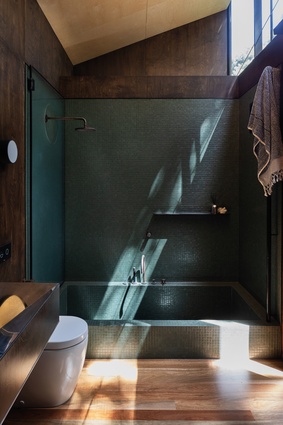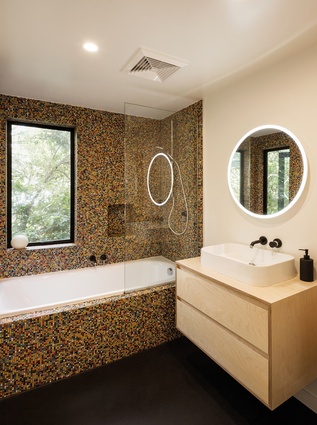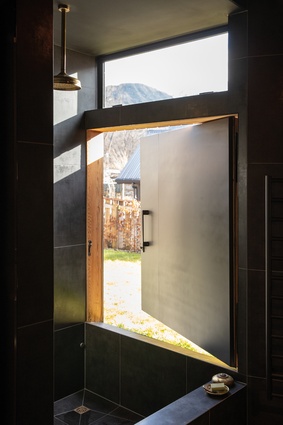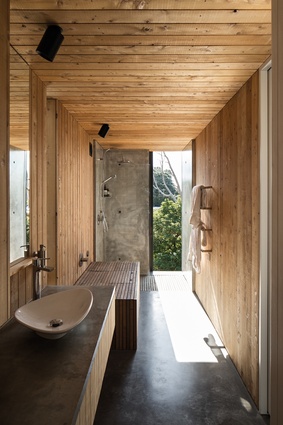2019 Bathroom focus: case studies
Four New Zealand designers and homeowners share insights from their favourite bathroom projects.

Uplifting the spirit
“Bathrooms can be purely functional or they can uplift the spirit and, at our home, we wanted to make washing and bathing an experience.
We chose the materials in our en suite for their robustness and practicality; they also thread through the rest of the home. In-situ concrete was used for the shower box, and Lawson cypress (an exterior cladding), with its texture and fragrant aroma, for the walls and ceiling, concrete and Lawson cypress for the vanity units, and Vitex duckboard to the shower floor.
The main outlook, offering prospect into the landscape to the west, is from the shower. Clear glazing allows views across the valley, with vegetation providing privacy, and a sliding, powder-coated aluminium screen adds to privacy when required, together with external summer sun-shading.
My wife and I don’t use a bath but we have three granddaughters so we made removable slatted covers to place over a standard bath. This slatted box is useful as a footrest and towel storage when not being used as a bath.”
— Dave Strachan, Strachan Group Architects

Hidden spaces
“Thanks to the restrictions of working with an existing crib, the new addition needed to accommodate an extra bathroom and laundry within the open-plan living, kitchen and dining area.
We wanted to create a quiet, intimate space within this busy part of the home so we placed the bathroom/laundry behind the living room bookcase and fireplace. The hidden bathroom is accessed through a section of the bookcase that opens to reveal a dark, cave-like space. This feeling of enclosure is emphasised by the large, black wall tiles, small footprint and concrete floors, which continue through from the living area. The brass fittings gain a patina over time and highlight the functionalities within the dark space.
Once inside, you feel quite removed from the happenings in the home. A high window gives a dramatic shaft of light and view to the mountains beyond while the solid external wall below can be opened to the outside, giving the kids access to the bathroom after a swim in the river or to sit in the oversized bath and stargaze.”
— Anna Rees-Hofmans, Hofmans Architects
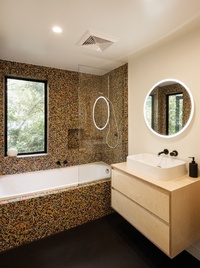
Frivolous and fun loving
“This is the family bathroom in a home that we built with designer Hamish Stirrat of Fabricate. We love that this space is a little bit fun and just a touch uncomfortable for some people: ‘skittles come ’80s’ arcade game’. We knew we didn’t want to play it safe and we hadn’t found much inspiration from other bathrooms that we were looking at, which were meant to be ‘on trend’.
When the people at Artedomus told us that no one else had been brave enough to use these Rainbow mosaic tiles, that was the clincher. Initially, we’d intended to use them only across the front of the bath but, we loved them so much, the area that they covered just seemed to keep expanding.
We kept the rest of the bathroom fairly simple, with the birch ply cabinetry and black floor continuing the theme found in the rest of the house, which has birch ply flooring throughout and black joinery.”
— Mindy Pilbrow, home-owner

At one with nature
“The interiors of this bathroom are an extension of the architecture, which influenced the materiality and form of the bathroom. As the roof lifts up, a clerestory band of windows offers glimpses of the surrounding trees and light reflects off the unstained birch ply roof lining.
In contrast, the stained walls pick up on the theme of the bush and are in keeping with the palette throughout the rest of the house. A glass mosaic Bisazza tile provides a beautiful translucent quality while the small module shapes the base of the shower and bath without the need to cut tiles.
In response to the compact building platform, the bath forms the base of the shower, with a hinged obscure glass wall folding back over the shower rose to allow for bathing. Blades of stainless steel form a shelf in the shower as well as a formed, shaped vanity, while the spotted gum flooring throughout the house continues into the bathroom.”
— Nicola Herbst, Herbst Architects
This article first appeared in Houses magazine.


